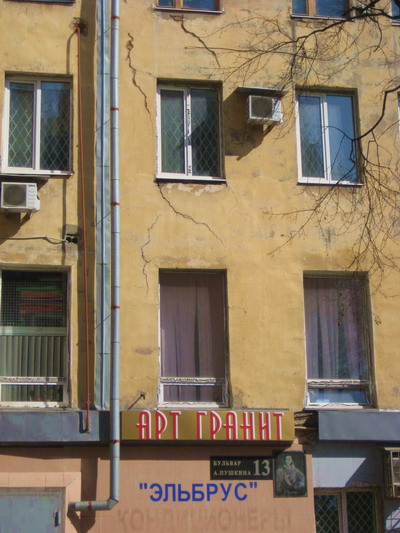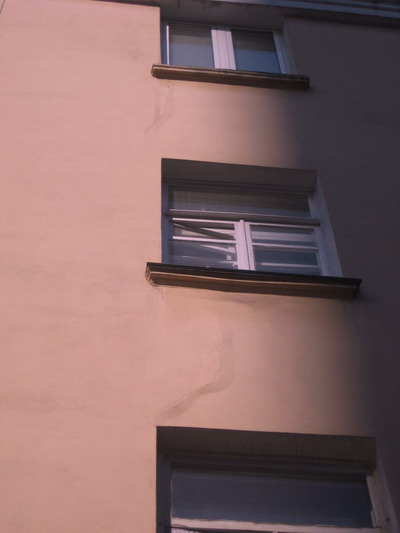
 Bonchuk Katya
Bonchuk KatyaMining and Geologikal faculty
Specialty: Landmanagement and Kadastr
Theme of dissertation:
Change of the state of civil buildings at earning additionally
Scientific consultant:
Krenida J.F.
Materials on the theme of master's work: About author
Actuality
Deformations of buildings arise up in connection with influence of different natural and anthropogenic (tekhnogennykh) factors, both on foundation and on self building.
As is generally known, underground development of deposits of minerals is accompanied moving of mountain breeds, that in most cases results in settling of earthly surface and its deformation. Depending on technology and method of conduct of mountain works, speed of advancement, power of layer, depth of conduct of works and other, settling of earthly surface can take place already during the conduct of mountain works, or after their completion, and can proceed during a few ten of years. It should be noted that influence of coulisse of coal on the state of earthly surface is observed even at the depth of development 1000 and more than meters.
Research of the state of civil buildings is major part of complex of works as evaluated by their technical state. At an inspection set actual bearing strength and service ability of bearings build constructions and foundation of building.
Program, volume and methods of inspection is set depending on that, for what aims conducted inspection, building character is which, his state etc. However in all cases inevitable to remain exposure of kind and estimation of the state of bearings constructions of building.
The purpose of work is research of change of the state of civil buildings at earning additionally.
During implementation of this work it is necessary to decide the followings scientific tasks:
- to expose the damages of buildings at the possible terms of earning additionally;
- to set the sizes of damage of buildings, being on not at earning additionally territory,
- to compare deformations of buildings at the possible terms of earning additionally and on the not earned additionally territory.
The object of research of work is determination of the state of influencing of earning additionally on deformation of buildings and buildings.
The article of research are civil buildings.
Damages at earning additionally.
Works which conduct at the coulisse of useful iskopaemogo or at preparation to the coulisse, named mountain works. As a result of these works free spaces which name the mountain making appear in the layer of mountain breeds.
Because of that breeds usually are not so strong, but considerable sizes have making, resilient deformations pass to plastic, there are breaks of sploshnosti and destruction of breeds begins.
Calculation deformations of grounds of the earned additionally objects
For planning of coulisse of coal from under building it is necessary to know his state after conducting of the cleansing making. Such prognosis is carried out on the basis of calculation deformations of earthly surface in the point of standing of building. These deformations set to deformations of foundation of building. For the estimation of size of affecting building of these deformations of foundation the index of total deformations, which takes into account the recurrence of earning additionally, is used

where l, H – is length and building height;
m – are coefficients of terms of work, middle accordingly horizontal deformations and curvature on length of building, accepted equal on the table of 1.1;
K – is maximal on an absolute value calculation horizontal deformations and curvature grounds which are determined on formulas:

Here e, K – are deformations and curvature grounds, set from the next making of n in order of their conducting,
n – is an amount of making.
Possible deformations of grounds of the earned additionally buildings.
Harm, inflicted the earned additionally buildings, consists of increase of wear of his constructions, decline of building longevity, and charges on repair-restoration works after earning additionally and increase of subsequent running expenses.
For the possible indexes of deformation of foundation of buildings and buildings such influences at which external environments will not be broken and for their providing there is the enough conducting of repair works are accepted.
The possible affecting buildings with incomplete framework is estimated the index of total deformations [l] and by the height of ledge [h] and determined formulas

Coefficients of Kg, Ks, Kp, Kf, Kr take into account the additional terms of influences accordingly are properties of soils of foundation, bearing ability of laying of bearings walls, construction and material of ceilings, configuration of building in a plan, remain of possible resource of influence after the next earning additionally.
Damages of buildings being on unearned additionally territory.
The possible damages of building, being on the not earned additionally territory, and his constructions classify on the followings basic signs:
· to reasons, to their causing;
· to the mechanism of corrosive process of destruction of constructions;
· to meaningfulness of consequences of destruction and labour intensiveness of renewal of buildings.
Reasons, causing the damages of buildings, it is been:
· influences of external natural (influencing of environment: temperetura air, sinking, wind, flood, thunderbolt) and artificial factors;
· geotectonics phenomena (tectonic motions, both vertical and horizontal, deformation, formation of folds, break violations and other, on an earthly surface);
· influence of internal factors, engineerings communications and equipment conditioned exploitation;
· display of errors, assumed at researches, planning and erection of buildings;
· failings and violation of rules of exploitation of buildings.
On the degree of destruction and meaningfulness of consequences it is possible to select three categories of damages:
1. Damages of emergency character, influences of different factors caused an aggregate, which renewal of separate parts or all building is executed because of.
2. Damage of basic elements of not emergency character, removed at major repairs or reconstruction.
3. Damages of second-rate elements (finishing, plaster, ceilings), removed at permanent repair.
Character of repair works on sealing-off of cracks.
In accordance with normative and recommendation documents all buildings and buildings must be recovered after earning additionally.
At autosediment repairs of the damaged buildings a plaster is repaired only and impermeability of joints is restored between the elements of constructions. Such repair does not restore former connections between the appearing blocks of walls or large elements of constructions, monolithic nature of walls is not restored. Renewal of connections between contiguous formations of the damaged constructions possibly by the way of inektion in the cracks of cement or polymeric solutions, laying of the damaged parts of walls and other However from a considerable cost these measures of renewal of monolithic nature of walls are not used.
Such damages, as removed layer by layer plaster, cracks which arise up in the places of interface of bearings walls, ceilings and partitions, removing layer by layer of repaired sealing-off, removing layer by layer and fall of facing tile and other damages, result in violation sanitary of technical norms in exploitation of apartments, create discomfort of residence. By reasons of such damages followings:
- it is absence of monolithic nature of laying of bearings walls, damaged cracks in the process of earning additionally, that does not provide connection between the separate blocks of wall, part cracks;
- are the dynamic affecting buildings, which contact with oscillation of foundation, caused seismic influence or influence of mechanisms, functionings inwardly or out of buildings;
- it is a proceeding uneven compression of layer of mountain breeds and, related to it, deformations of foundation, aggravating unregulated moving of separate blocks of walls of buildings;
- seasonal changes of the state of grounds the state of which changed in the process of earning additionally, and, related to it, unregulated moving of separate blocks of walls.

(Animation is created by Microsoft GIF Animator,
rozmer 108 Kb, size 151125 points, 6 shots,
delay 60, repeats oneself 100 times)
Method of inspection
Now the studies of problem of change of the state of civil buildings were inspected objects in Donetsk, which are on the street of Artema, bulv. Pushkina, pr. Mayakovskogo.
At the inspection of buildings the second damages of next character were set.
Along the edges of cracks, opening more than 1 mm, there is decorticating of whitewashing. The removed layer by layer and recovered plaster continues to be removed layer by layer and peel off. In the places of interface of bearings walls, ceilings and partitions there are removing layer by layer of repaired sealing-off. Removing layer by layer and fall of facing tile proceed from outside of bearings walls. The defects of openings, showing up in the lack of coincidence of mobile elements of constructions of windows and doors, proceed, removing layer by layer and falling of facing tile takes place also, that dangerously for passers-by. Along deformation stitches there is warping of is a splat.
On a photo 1 the south facade of building, being to address of bul is presented. Pushkina, 13. Opening of cracks from 2 to 8 mm. Cracks are vertical and slanting, being in between floor belts, also there is removing layer by layer of plaster.

Photo 1 - bulv. Pushkina, 13, south a fasade
Photo 2 the east facade of building is represented WAIT. Walls of building also of the second damage. Cracks opening of which 1,5-3 mm. are here visible It is vertical cracks. The recovered plaster continues to be removed layer by layer and peel off.

Photo 2 is a street of Artema, 70, the east facade of building
These deformations were fixed on the chamber of canon digital ixus 70, 7.1 mega pixels. A survey was made in clear, sun weather, at 9 o'clock of morning, in March, 2009.
Buildings, being on unearned additionally territory probed for comparing to the damages of buildings, which are on the earned additionally territory, that in future at the study of problem to know the degree of deformation of civil buildings.
Used literature.
1. Анциферов А.В., Кренида Ю.Ф., Тиркель М.Г. Подработка зданий и сооружений шахтерских городов и поселков. Учебное пособие. - Донецк. Технопарк ДонНТУ "УНІТЕХ", 2006. 230 с.
2. Гавриленко Ю.Н., . Ермаков В.Н, Кренида Ю.Ф., .Улицкий О.А, Дрибан В.А., Техногенные последствия закрытия угольных шахт Украины; Норд-Пресс, 2004. 485 с.
3. Оглоблин Д.Н., Бастан П.П., Герасименко Г.И., Никольский С.И., Папазов М.Г., Травник С.Ф., Фисенко Г.Л. Маркшейдерское дело. Издание 2-е, переработанное и дополненное. М. «Недра», 1972. 584 с.
4. Все о строительных технологиях, материалах. [Электронный ресурс] http://www.budinvest.com.ua
5. Ремонтные работы деформированных зданий. [Электронный ресурс] http://www.mukhin.ru/stroysovet/kladka/16_3.html
6. Ананьева Ю.А. Разработка системы прогноза допустимых показателей деформации земной поверхности для подрабатываемых зданий и сооружений. [Электронный ресурс] / Персональный сайт Ананьева Ю.А., http://www.masters.donntu.ru/2006/ggeo/ananyeva/diss/index.htm
7. Земисев В.Н. Расчеты деформаций горного массива, «Недра», 1973. 144 с.
8. Правила обследований, оценки технического состояния и паспортизации производственнных зданий и сооружений. [Электронный ресурс]
http://www.sot.donetsk.ua/Pravila/prv10_4.htm
>> Upwards